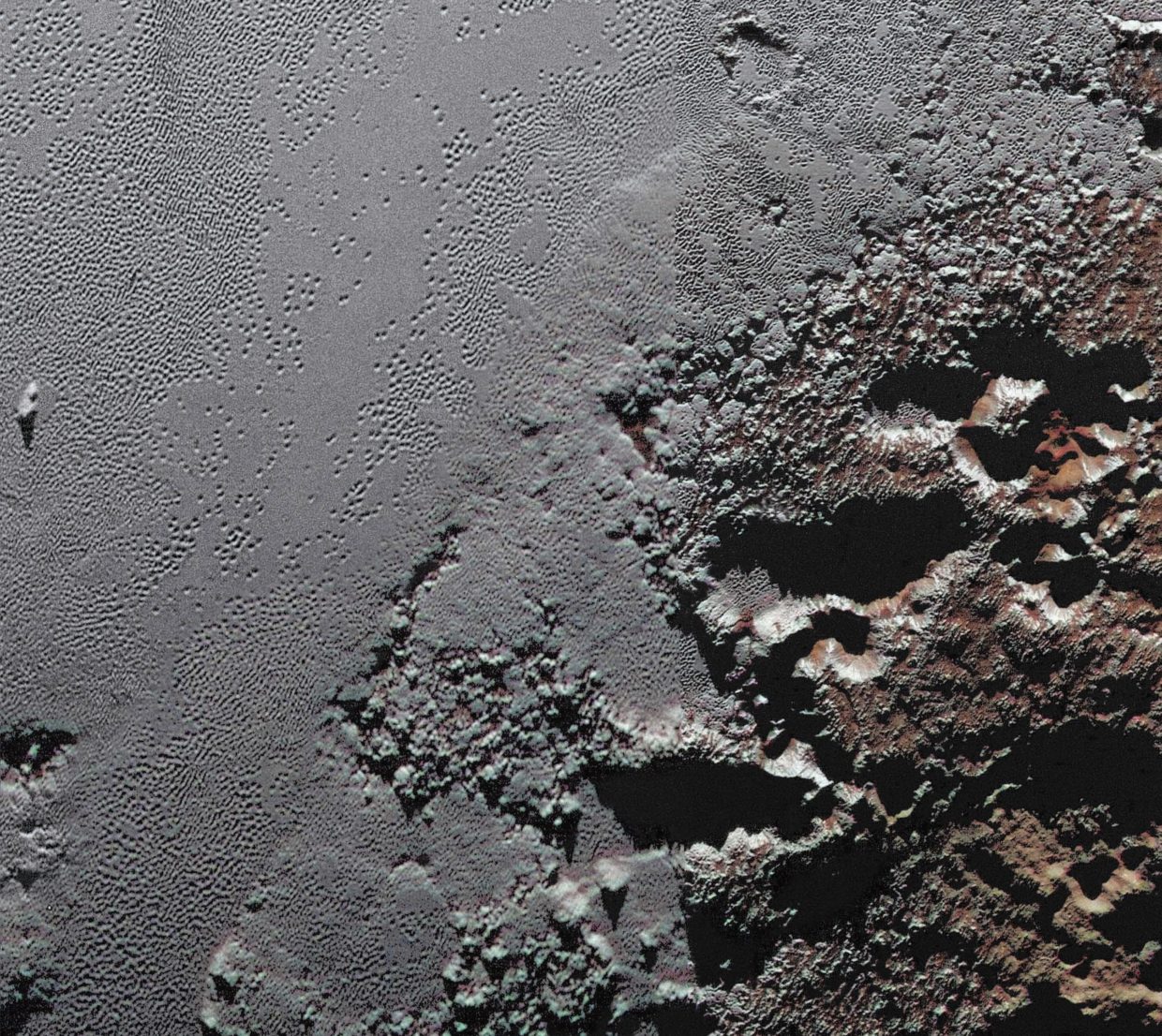
One year ago today, NASA’s New Horizons probe whizzed past Pluto and opened up a new frontier for planetary science – and to mark the occasion, the mission team is looking back at its greatest hits and looking ahead to a landing.
“It’s strange to think that only a year ago, we still had no real idea of what the Pluto system was like,” project scientist Hal Weaver, who’s based at the Johns Hopkins University Applied Physics Laboratory, said in a news release celebrating the anniversary. “But it didn’t take long for us to realize Pluto was something special, and like nothing we ever could have expected.”
After more than nine years of cruising through interplanetary space, the piano-sized New Horizons spacecraft flew by Pluto and its moons at a speed of more than 30,000 mph on July 14, 2015, capturing readings as it went. Since then, the probe has been transmitting gigabytes’ worth of data back to Earth at a slow but steady rate.
The pictures have been unprecedented, providing the first close look at icy worlds that whirl more than 3 billion miles from the sun, in a region known as the Kuiper Belt. They’ve even inspired a set of postage stamps. Check out NASA’s gallery of the mission’s top 10 pictures:
- New Horizons discovers flowing ices in the northern region of Sputnik Planum. (Credit for all pictures: NASA / JHUAPL / SwRI)
- This New Horizons image shows the dark, rugged highlands known as Krun Macula (lower right), which border a section of Pluto’s icy plains.
- A backlit picture taken after New Horizons’ flyby highights the Pluto’s bluish haze..
- An enhanced color picture of Charon, Pluto’s biggest moon, highlights its polar red spot.
- Just after closest approach, New Horizons’ backward-looking view of Pluto shows more than a dozen distinct layers of atmospheric haze above Pluto’s surface.
- A composite image shows enhanced-color views of Pluto (lower right) and Charon (upper left). Credit: NASA / JHUAPL / SwRI
- This New Horizons image reveals that an area of Pluto known as Tartarus Dorsa is covered with bladed ice structures known as “snakeskin terrain.”
- New Horizons’ best-known picture of Pluto highlights a heart-shaped region of bright ice.
- The inset pictures show a section of Pluto’s Cthulhu Regio that includes a reddish plain as well as a mountain range. The far right inset indicates the distribution of methane ice in purple.
- These color-coded compositional maps of Pluto indicate the regions that are rich in ices of methane (CH4), nitrogen (N2), carbon monoxide (CH) and water ice (H2O).
Meanwhile, principal investigator Alan Stern, a planetary scientist at the Southwest Research Institute, highlighted the top 10 surprises so far:
- Pluto and its satellites are far more complex than expected.
- Pluto’s surface shows ample signs of recent geological activity.
- Pluto has a hazier and more stable atmosphere than predicted.
- Pluto’s biggest moon, Charon, looks as if it has a frozen interior ocean, and Pluto itself could well have an internal water-ice ocean today.
- Pluto’s moons appear to have roughly the same age, boosting the theory that they were all formed in the wake of a single collision between a proto-Pluto and another icy object billions of years ago.
- Charon’s dark red polar cap may be the result of atmospheric gases that escaped Pluto and built up as a layer on the moon’s surface.
- Pluto’s 600-mile-wide, heart-shaped field of frozen nitrogen – informally known as Sputnik Planum – is arguably the solar system’s largest known glacier.
- Pluto shows evidence of vast changes in atmospheric pressure, and possibly the past presence of running or standing liquid volatiles on its surface.
- One surprise of a different sort was the failure to detect any more satellites beyond the five that were found before the flyby.
- Pluto’s atmosphere is blue.
New Horizons is far from finished: The probe is expected to continue sending data from the flyby through October. Then the mission team will turn its full attention to preparations for another flyby. The 2019 encounter will focus on a smaller Kuiper Belt object known as 2014 MU69, about a billion miles beyond Pluto.
To cap off today’s anniversary of the Pluto flyby, New Horizons’ scientists stitched together images to create a video hinting at what a lander might see as it zeroes in on the dwarf planet.
“The challenge in creating this movie is to make it feel like you’re diving into Pluto,” Constantine Tsang, a New Horizons scientist at the Southwest Research Institute who worked with Stern to create the clip, said in a news release. “We had to interpolate some of the frames based on what we know Pluto looks like to make it as smooth and seamless as possible. It’s certainly fun to see this and think what it would feel like to approach a landing on Pluto!”
Could it ever happen? There’s no Pluto lander in the works. NASA says it has higher interplanetary priorities, such as looking for signs of life on Mars and the ice-covered moons of Jupiter and Saturn. But Stern has said he’s thought about designing a “hyper orbiter” that could land on Charon and keep watch on Pluto from nearby. So although it’s a long shot, there may be yet another new horizon ahead for Pluto explorers.













